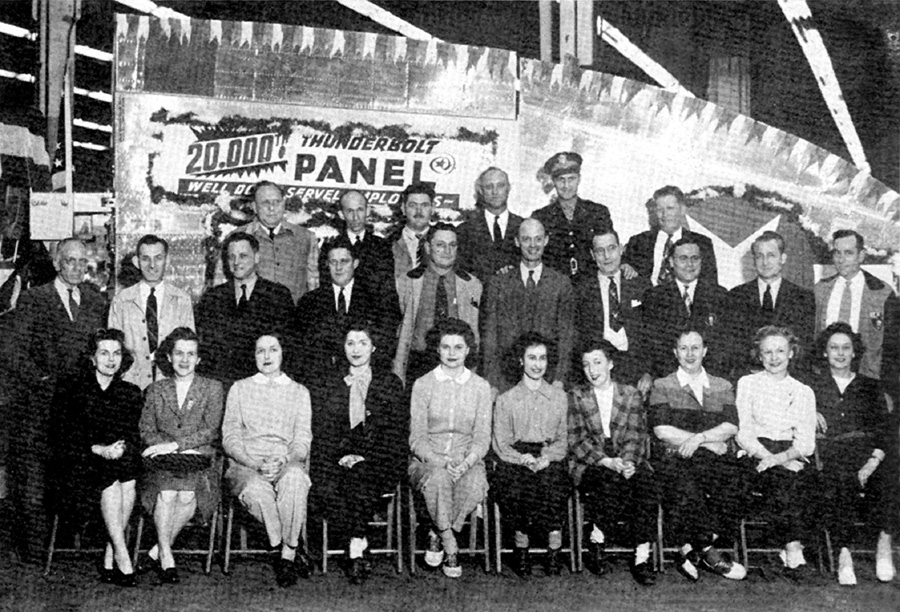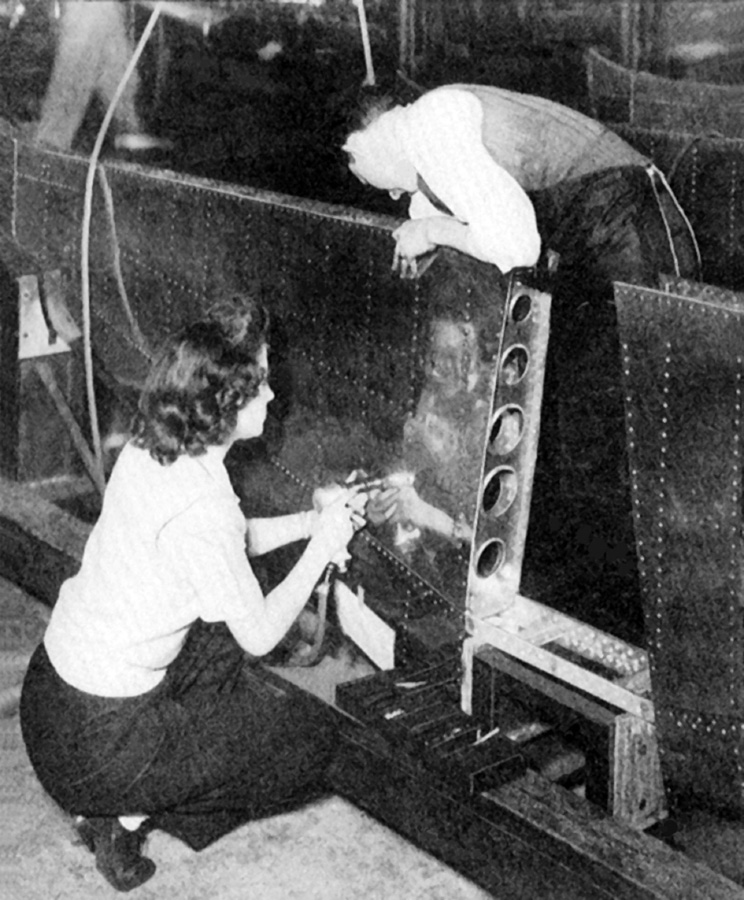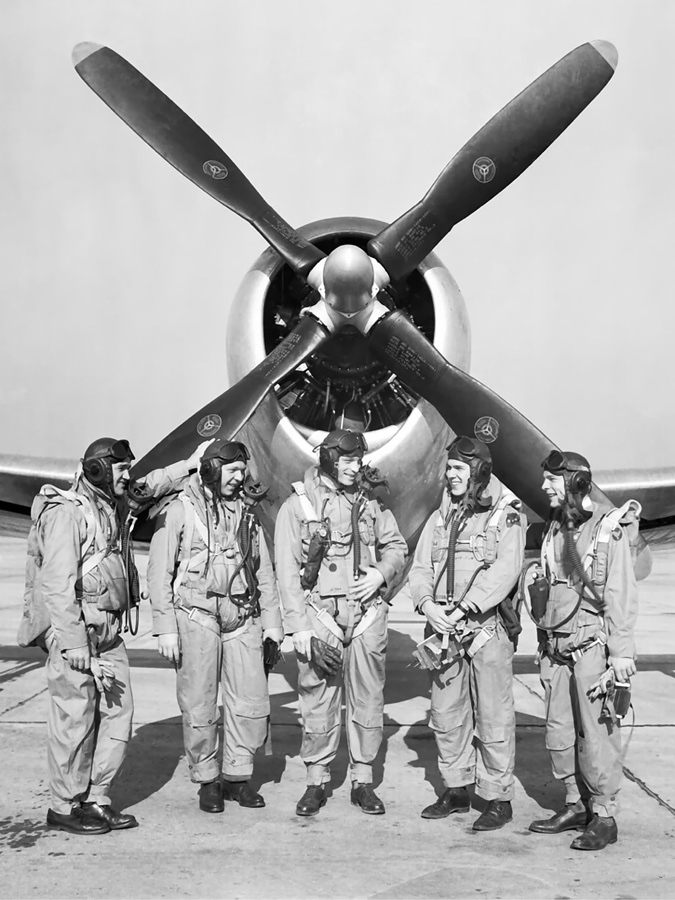- Tour Our Sites:
- Restoration
- Depot
- Library
- Fabrication
- Art
The fuselage extension, cockpit enclosure, and wings were the centers of activity in the restoration shop this month. We will also look into Republic Aviation and Evansville, Indiana’s part in the Arsenal of Democracy.
The ongoing planning for next spring’s Arsenal of Democracy Flyover, celebrating the 75th anniversary of VE Day, suggests that a brief history of Republic Aviation Corporation’s part in the famed arsenal is a timely subject.
The Arsenal of Democracy term was first used by President Franklin Delano Roosevelt in a 1940 radio broadcast to describe the need for production efforts to aid Great Britain to defeat the Axis Powers.
After the United States entered the war, the Arsenal of Democracy term expanded to signify the massive unified effort that men, women, manufacturers and the military forces accomplished to produce and utilize the tools of war.
Again in FDR’s words, a month after Pearl Harbor “Powerful enemies must be out-fought and out-produced, It is not enough to turn out just a few more planes, a few more tanks, a few more guns, a few more ships than can be turned out by our enemies,” he said. “We must out-produce them overwhelmingly, so that there can be no question of our ability to provide a crushing superiority of equipment in any theatre of the world war.”
The ramp-up in manufacturing was extraordinary and every sector of American society played its part.
Figures that illustrate the production increases in the aviation sector include growth in annual production from 6,000 aircraft in 1939 to a peak of 9,000 in the single month of March of 1944.
The United States built more planes in 1944 than the Japanese did from 1939 to 1945!
Republic Aviation was a major part of the expansion of production that made victory a reality .
The first P-47s reached England in late December 1942. There were 88 of the big fighters shipped to the 8th Air Force. These were P-47Cs produced at the Farmingdale, N.Y. Republic factory. It was March 10, 1943 before the first operational sweep by the 4th Fighter Group consisting of 14 P-47Cs.2
By February 1943, the P-47D was coming off the production line. Republic had foreseen major demand for the Thunderbolt and ground was broken for another factory in Evansville, Indiana on April 11, 1942. By September, the first Evansville P-47 flew. Eventually, 15,579 P-47s would be built, more than any other USAAF fighter. They equipped 40 percent of overseas fighter groups in 1944 and 1945.
Aircraft factories became more efficient, and engineering changes streamlined production as the war went on. Harold Morgan’s book Home Front Warriors3 mentions several interesting figures on production costs and man hours.
The early D models built in Evansville each required 22,927 man hours, and cost $69,750. By September of 1944, man hours were reduced to 6,290 and cost to $45,600.
Design changes were a large part of the cost reductions.
They included:
1 Harold B. Morgan Homefront Warriors, Mount Vernon, IN Harold B. Morgan, 2011, p.38
2 Roger Freeman, Thunderbolt, a Documentary History of the Republic P-47, New York: Charles Scribner’s Sons, 1979, p 31
3 Harold B. Morgan Homefront Warriors, Mount Vernon, IN Harold B. Morgan, 2011, p.4
4 Harold B. Morgan Homefront Warriors, Mount Vernon, IN Harold B. Morgan, 2011, p.4
Republic and all the other major aircraft manufacturers depended on subcontractors to support the massive production effort that was needed during the war. Many of those were companies that produced consumer goods before the war and had to completely change their production over to aircraft parts or assembly. A few of the more important subcontractors for the Evansville Republic plant were:



Evansville, Indiana had many more contributions to the Arsenal of Democracy. Parts and subassemblies for the F4F Wildcat, F4U Corsair, PBY, B-29, and others were built in Evansville. The major non-aviation related product was 167 LSTs (Landing Ship Tank) produced at the Missouri Valley Bridge and Iron Company shipyard.
Chrysler’s Evansville Plymouth Automobile plant was converted to production of .45 automatic sidearm cartridges, and they also rebuilt 1,600 Sherman tanks, and 4,000 military trucks. Chrysler’s Evansville arsenal produced over 3.2 billion .45 caliber ACP cartridges, 96% of the US wartime production in that caliber.
Evansville also sewed uniforms, and supplied components of plastic, wood, and metal for weaponry, combat vehicles, and long-range bombers.
In fact, during World War II, Evansville became the most productive war materials manufacturing city in the world per capita.5
5 Reghan Wetzel,Communication Intern, University of Southern Indiana’s Center for Applied Research and Economic Development (CARED), Freedom Heritage Museum write up, https://www.usi.edu/media/3028464/FHM-write-up-2013-PDF.pdf,, downloaded 6-13-2019